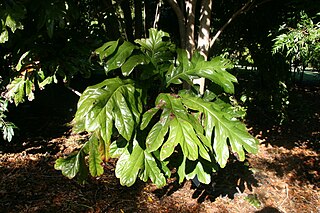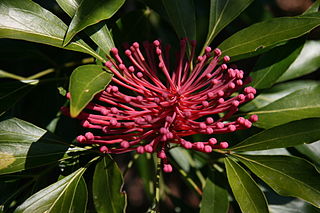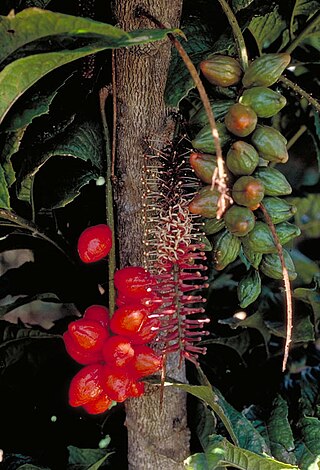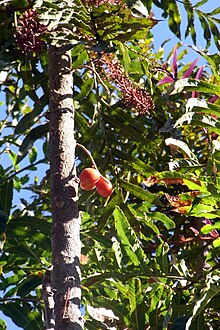
Macadamia is a genus of four species of trees in the flowering plant family Proteaceae. They are indigenous to Australia, native to northeastern New South Wales and central and southeastern Queensland specifically. Two species of the genus are commercially important for their fruit, the macadamia nut. Global production in 2015 was 160,000 tonnes. Other names include Queensland nut, bush nut, maroochi nut, bauple nut and, in the US, they are also known as Hawaii nut. It was an important source of bushfood for the Aboriginal peoples.

Floydia is a monotypic genus of plants in the Proteaceae family endemic to Australia. The sole described species is Floydia praealta, commonly known as the ball nut. It is a somewhat rare tree found only growing in the rainforests of southeastern Queensland and northeastern New South Wales. The tree has a superficial resemblance to the closely related Macadamia and could be confused with them. The fruit is poisonous.

Athertonia is a monotypic genus of plants in the family Proteaceae. The sole described species is Athertonia diversifolia, commonly known as Atherton oak, athertonia, creamy silky oak or white oak. It is endemic to a small part of the Wet Tropics of Queensland, Australia. A relative of the macadamia, it has potential in horticulture and the bushfood industry.

Eidothea is a genus of two species of rainforest trees in New South Wales and Queensland, in eastern Australia, constituting part of the plant family Proteaceae. The plant family Proteaceae was named after the shape-shifting god Proteus of Greek mythology. The genus name Eidothea refers to one of the three daughters of Proteus.

The Proteaceae form a family of flowering plants predominantly distributed in the Southern Hemisphere. The family comprises 83 genera with about 1,660 known species. Australia and South Africa have the greatest concentrations of diversity. Together with the Platanaceae, Nelumbonaceae and in the recent APG IV system the Sabiaceae, they make up the order Proteales. Well-known Proteaceae genera include Protea, Banksia, Embothrium, Grevillea, Hakea, and Macadamia. Species such as the New South Wales waratah, king protea, and various species of Banksia, Grevillea, and Leucadendron are popular cut flowers. The nuts of Macadamia integrifolia are widely grown commercially and consumed, as are those of Gevuina avellana on a smaller scale.

The Grevilleoideae are a subfamily of the plant family Proteaceae. Mainly restricted to the Southern Hemisphere, it contains around 46 genera and about 950 species. Genera include Banksia, Grevillea, and Macadamia.

Triunia is a genus of medium to tall shrubs or small trees found as understorey plants in rainforests of eastern Australia. Members of the plant family Proteaceae, they are notable for their poisonous fleshy fruits or drupes. Only one species, T. youngiana, is commonly seen in cultivation.

Alloxylon flammeum, commonly known as the Queensland tree waratah or red silky oak, is a medium-sized tree of the family Proteaceae found in the Queensland tropical rain forests of northeastern Australia. It has shiny green elliptical leaves up to 18 cm (7.1 in) long, and prominent orange-red inflorescences that appear from August to October, followed by rectangular woody seed pods that ripen in February and March. Juvenile plants have large deeply lobed pinnate leaves. Previously known as Oreocallis wickhamii, the initial specimen turned out to be a different species to the one cultivated and hence a new scientific name was required. Described formally by Peter Weston and Mike Crisp in 1991, A. flammeum was designated the type species of the genus Alloxylon. This genus contains the four species previously classified in Oreocallis that are found in Australasia.

Bleasdalea is a genus of flowering plants in the family Proteaceae.

The flora of Australia comprises a vast assemblage of plant species estimated to over 21,000 vascular and 14,000 non-vascular plants, 250,000 species of fungi and over 3,000 lichens. The flora has strong affinities with the flora of Gondwana, and below the family level has a highly endemic angiosperm flora whose diversity was shaped by the effects of continental drift and climate change since the Cretaceous. Prominent features of the Australian flora are adaptations to aridity and fire which include scleromorphy and serotiny. These adaptations are common in species from the large and well-known families Proteaceae (Banksia), Myrtaceae, and Fabaceae.

Cardwellia is a monotypic genus in the plant family Proteaceae. The sole described species is Cardwellia sublimis − commonly known as northern silky oak, bull oak or lacewood − which is endemic to the rainforests of northeastern Queensland, Australia.

Hicksbeachia pinnatifolia is a small tree in the family Proteaceae. Common names include red bopple nut, monkey nut, red nut, beef nut, rose nut and ivory silky oak.

Telopea truncata, commonly known as the Tasmanian waratah, is a plant in the family Proteaceae. It is endemic to Tasmania where it is found on moist acidic soils at altitudes of 600 to 1200 m (2000–4000 ft). Telopea truncata is a component of alpine eucalypt forest, rainforest and scrub communities. It grows as a multistemmed shrub to a height of 3 metres (10 ft), or occasionally as a small tree to 10 m (35 ft) high, with red flower heads, known as inflorescences, appearing over the Tasmanian summer and bearing 10 to 35 individual flowers. Yellow-flowered forms are occasionally seen, but do not form a population distinct from the rest of the species.

Alloxylon pinnatum, known as Dorrigo waratah, is a tree of the family Proteaceae found in warm-temperate rainforest of south-east Queensland and northern New South Wales in eastern Australia. It has shiny green leaves that are either pinnate (lobed) and up to 30 cm (12 in) long, or lanceolate (spear-shaped) and up to 15 cm (5.9 in) long. The prominent pinkish-red flower heads, known as inflorescences, appear in spring and summer; these are made up of 50 to 140 individual flowers arranged in corymb or raceme. These are followed by rectangular woody seed pods, which bear two rows of winged seeds.

Oreocallis is a South American plant genus in the family Proteaceae. There is only one species, Oreocallis grandiflora, which is native to mountainous regions in Peru and Ecuador.

Hicksbeachia pilosa is a small tree in the family Proteaceae. This rare species is endemic to the rainforests of the wet tropics region of northeastern Queensland, Australia. It was first described in 1988 by Australian botanist Peter H. Weston, after a collection by Garry Sankowsky and Peter Hind in 1986 at Bobbin Bobbin Falls in North Queensland. Its specific name is the Latin adjective pilosus "hairy".
Hollandaea is a small genus of plants in the family Proteaceae containing four species of Australian rainforest trees. All four species are endemic to restricted areas of the Wet Tropics of northeast Queensland.

Opisthiolepis is a monotypic genus of trees in the macadamia family Proteaceae. The sole species is Opisthiolepis heterophylla, commonly known as blush silky oak, pink silky oak, brown silky oak or drunk rabbit. It was first described in 1952 and is endemic to a small part of northeastern Queensland, Australia.

Placospermum is a genus of a single species of large trees, constituting part of the plant family Proteaceae. The species Placospermum coriaceum is endemic to the rainforests of the wet tropics region of northeastern Queensland, Australia. Common names include rose silky oak and plate-seeded oak.

Lasjia is a genus of six species of trees of the family Proteaceae. Three species grow naturally in northeastern Queensland, Australia and three species in Sulawesi, Indonesia. Descriptively they are the tropical or northern macadamia trees group. Lasjia species characteristically branched compound inflorescences differentiate them from the Macadamia species, of Australia, which have characteristically unbranched compound inflorescences and only grow naturally about 1,000 km (620 mi) further to the south, in southern and central eastern Queensland and in northeastern New South Wales.



















